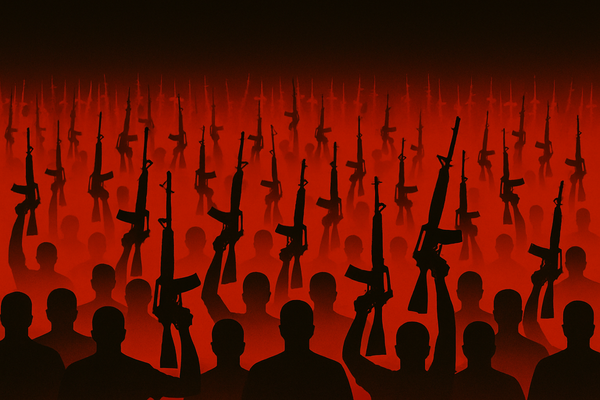America Doesn’t Really Have a Far-Left

For years, American politics has been described in terms of left versus right, liberal versus conservative, Democrat versus Republican.
But that framing is misleading, because the so-called “far-left” in the United States is nothing of the sort. In truth, what passes for the “radical left” in America would barely qualify as center-left anywhere else in the developed world.

The viral post by journalist Jules Suzdaltsev captures this perfectly. He points out that the American “far-left” is made up of people simply trying to keep human beings from dying in medical poverty.
That’s hardly revolutionary. In fact, on an objective political compass, figures like Bernie Sanders or Elizabeth Warren would be placed just slightly left of center, hardly Marxists storming the barricades.
Meanwhile, the actual right-wing landscape in the U.S. has shifted so far that what once would have been considered extremist is now mainstream.
We see fascist-adjacent rhetoric normalized, center-right politics defined by nationalism, and a political culture where policies that are basic social safety nets in other democracies are painted as communism.
What a Real Far-Left Looks Like
If we’re being honest, a genuine far-left movement would look very different.
Historically, far-left politics has included direct calls for worker ownership of industry, forced redistribution of land and wealth, and outright nationalization of private property. In other words, seizing the means of production, not politely asking billionaires to pay a slightly higher marginal tax rate.
Compare that to America’s so-called radical proposals: universal healthcare, student debt forgiveness, or paid parental leave. These are standard policies in most industrialized nations, yet in the U.S. they’re branded as dangerously socialist. That distortion reveals more about America’s political Overton Window, (the range of ideas considered acceptable) than about the actual policies themselves.
The American Paradox
So why does America lack a true far-left? Two main reasons stand out.
First, the legacy of Cold War anti-communism cemented a deep suspicion of anything smelling of socialism. For decades, even moderate reforms have been attacked as creeping communism.
Second, the sheer power of corporate lobbying and money in politics ensures that the spectrum of debate remains tightly controlled.
Policies that challenge wealth and property ownership too directly are not only marginalized, they’re treated as existential threats to the system.
This leaves America with a strange paradox: the right is extreme and authoritarian in ways that would be alarming anywhere else, while the left is moderate and reformist but branded as radical. The imbalance distorts public discourse and makes compromise almost impossible, because one side plays with apocalyptic stakes while the other side begs for incremental change.
Where This Leaves Us
Suzdaltsev’s post cuts to the heart of it: America does not have a far-left. It has moderates painted as radicals, and radicals painted as enemies of the state. The result is a political system where even the mildest attempt to expand healthcare, education, or labor rights is treated as revolutionary overreach.
That distortion benefits those already in power. As long as Americans believe universal healthcare is socialism, they’ll never notice that the real redistribution, the upward siphoning of wealth and resources, has been happening all along.
Economic Systems
Capitalism
At its core, capitalism is private ownership of the means of production, factories, land, businesses, where goods and services are produced for profit. Prices and wages are determined (in theory) by free markets. Wealth accumulates in private hands, and the state is supposed to act as referee rather than owner. The upside is innovation and efficiency; the downside is inequality and exploitation.
Socialism
Socialism steps in and says: the means of production should be owned or controlled collectively, by the people, usually through the state or through worker cooperatives. The goal is to reduce inequality by redistributing wealth, ensuring access to basics like healthcare, housing, and education. Profit is not abolished, but it’s subordinated to social welfare. Think Scandinavia for the softer versions, or Cuba for the harder ones.
Communism
Communism is socialism taken to its logical endpoint: the abolition of private property, money, and classes altogether. In theory, everyone contributes according to ability and receives according to need. The state eventually “withers away” because equality eliminates the need for rulers. In practice, the attempts we’ve seen (Soviet Union, Maoist China) ended up with powerful states that didn’t wither, but devoured.
NOTE: There is no pure "communist" country in the world today. In fact, there is no such thing as a stateless country. Pure communism is stateless, as in there is no state, no government, no rulers. Clearly this is not the case with the "communist" nations that exist today like Russia, China, North Korea, etc.
A key correction most people miss when they throw “communist” around as a label, there's no such thing as a "communist state". That phrase is literally an oxymoron.
Marx’s original framework sets communism as the end state of social evolution: a classless, stateless society where production is organized for human need, not profit, and coercive government disappears because there are no classes to police.
By definition, if there’s a state, it isn’t communism yet.
What we’ve actually seen in history are socialist states or authoritarian regimes that call themselves communist. Lenin and later Marxists described this transitional period as the “dictatorship of the proletariat,” where the state temporarily seizes power to suppress old ruling classes and restructure society. In practice, that “temporary” state never withered away. Instead, it grew into centralized, bureaucratic, and often repressive apparatuses.
That’s why countries like China, North Korea, or the former Soviet Union were never truly “communist.” They were (and are) highly statist. China today is arguably closer to state capitalism: a one-party state using markets and private capital under authoritarian control. North Korea is essentially a dynastic dictatorship draped in socialist language.
- No stateless societies exist at national scale. Even tribal or small communal systems had structures of authority, though diffuse.
- No country has reached “pure communism.” What people call “communist countries” are better described as authoritarian socialist states (at best) or outright dictatorships (at worst).
This distinction matters, because in political arguments, “communism” often gets used as a scare word. But the real debate in the modern world isn’t between capitalism and communism; it’s between variations of capitalism (regulated vs laissez-faire vs state-directed) and limited forms of socialism (safety nets, redistribution, public services).
Political Philosophies
Liberalism
Not “leftist” in the revolutionary sense. Liberalism means belief in individual rights, representative democracy, and the rule of law. It grew out of Enlightenment thought and was radical in its day because it challenged monarchs and aristocrats. In modern U.S. politics, “liberal” usually means favoring moderate reforms, social safety nets, and civil rights, but still within the framework of capitalism.
Conservatism
Conservatism is about preserving tradition, stability, and hierarchy. Historically, it defended monarchs, churches, and social orders against liberal revolutions. In today’s U.S. context, it tends to emphasize free markets, limited government (except when regulating morality), strong national identity, and skepticism toward rapid social change. At its extreme, conservatism drifts into nationalism and authoritarianism.
Libertarianism
The purest distillation of “leave me alone.” Libertarianism demands maximum personal freedom and minimal government. Economically, that means no taxes, no welfare, no regulation—just free markets. Socially, it can overlap with liberalism on things like free speech, drug legalization, and privacy. The paradox is that true libertarianism often ends up empowering corporations (which become mini-governments) because without regulation, the biggest players dominate.
Anti-Fascist Anarchism (Antifa, broadly)
This is a militant rejection of both fascism and hierarchical authority itself. Anarchists oppose the state, capitalism, and all forms of domination. Instead, they advocate decentralized, horizontal communities based on voluntary cooperation and mutual aid. Antifascist anarchists focus on direct action—counter-demonstrations, physical resistance, community defense—because they see fascism as something that can’t be debated away; it has to be confronted head-on.
There’s a funny irony here: anarchists and libertarians often think of themselves as polar opposites, but if you look closely, they have more in common than they’d like to admit. Both reject centralized authority. Both hate the state telling them what to do. Both want maximum personal freedom. The split is in what they fear most:
Libertarians fear government above all. They want unfettered free markets, no regulation, and the idea that voluntary contracts will sort things out. To them, capitalism is the natural expression of liberty.
Anarchists fear hierarchy itself—government, corporations, landlords, bosses. They see capitalism as just another system of domination, no different from monarchy or dictatorship. They want decentralized, cooperative communities without rulers or owners.
So on the spectrum, libertarians want freedom through markets, anarchists want freedom from markets. Libertarians envision a society of independent individuals trading freely; anarchists envision networks of mutual aid and collective decision-making.
In practice, both camps end up aligned against state power. Both resist government surveillance, compulsory military service, censorship, police overreach, and centralized bureaucracies. Both value decentralization and voluntary association.
The friction is that libertarians shrug at corporations because they see them as voluntary. Anarchists see corporations as private governments that rule workers and communities without consent. But the structural similarity—the urge to smash centralized authority—is why they sometimes look like estranged cousins who took radically different paths but wound up living across the street.
What ties this together is that economic systems (capitalism, socialism, communism) describe who owns stuff, while political philosophies (liberalism, conservatism, libertarianism, anarchism) describe who holds power and how society should be run. The two constantly mix, clash, and mutate—producing the messy stew we call politics.
America doesn’t have a far-left.
It has a political spectrum where moderates are branded as radicals, and where even the simplest reforms are treated like revolution. That distortion doesn’t just warp the conversation, it keeps the country stuck.
The real fight isn’t about radicalism at all. It’s about whether people deserve basic human and civil rights, and the respect and dignity to live freely as themselves.
America used to sell us a dream. But over time, the price of that dream was raised higher than most could ever afford. If the cost of chasing that dream is our freedom, then it isn’t a dream worth buying. It’s time to demand that those who set the price of freedom stop holding it hostage.





